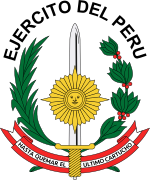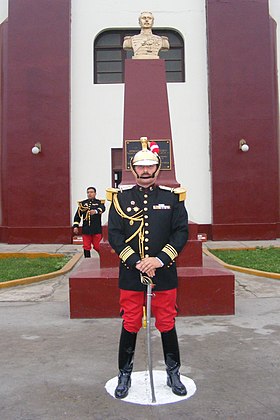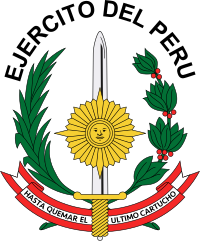Peruvian Army
| Peruvian Army |
|---|
 |
| History |
|
History of the Peruvian Army Battles of the Peruvian Army |
| Personnel |
|
Army commanders Rank insignia |
| Other |
| Military Academy |
The Peruvian Army (
History
Military traditions in Peruvian territory go back to
Independence
The Ejército del Perú was officially established on August 18, 1821, when the government of general José de San Martín established the Legión Peruana de la Guardia (Peruvian Guard Legion), although some militia units had been formed before. Peruvian troops were key participants in the final campaign against Spanish rule in South America, under the leadership of general Simón Bolívar, which ended victoriously in the battles of Junín and Ayacucho in 1824.
19th century

Painting by Juan Lepiani
After the
20th century
During the early years of the 20th century the Peruvian Army underwent a series of reforms under the guidance of the French Military Mission which operated in the periods 1896–1914, 1919–1924 and 1932–1939. Changes included the streamlining of the

Even though the Peruvian Army was not involved in World War II, this conflict had a significant effect in its development, mainly through the replacement of French military influence by that of the United States. A US military mission started operations in 1945 followed by an influx of surplus American military equipment delivered as military aid or sold at a very low cost.
Washington also established itself as the leader of continental defense through the creation of the Inter-American Defense Board in 1942 and the signing of the Inter-American Treaty of Reciprocal Assistance in 1947. A parallel development was the founding in 1950 of the Centro de Altos Estudios Militares (CAEM, Center of High Military Studies) for the formation of officers in the major problems of the nation beyond those related to its military defense.
The Peruvian Army was the main protagonist of the Gobierno Revolucionario de las Fuerzas Armadas (Revolutionary Government of the Armed Forces), an institutionalized
In 1981 during the government of
The presidency of
21st century

The downfall of the Alberto Fujimori regime left the Peruvian Army in a difficult state, with some of its senior officers compromised in scandals of corruption and human rights violations. Several reforms were undertaken during the presidencies of Valentín Paniagua (2000–2001) and Alejandro Toledo (2001–2006), among them the prosecution of criminal cases related to the military, the reorganization of the military rank system and an increased civilian supervision through a revamped Ministry of Defense. The outcome of this and other initiatives is a major factor of order, major preparation, new equipment and development of the Ejército del Perú. G-3 America (G3 and Associates International Corporation) facilitated the incorporation of new technology to eliminate or reduce terrorism. They have been working tenaciously in getting the right equipment for the Armed Forces while working with the US State Department and US companies to accomplish it.
The Ollanta Humalla administration has also had the Army engaged in training members of Peru's indigenous peoples for the duties of national defense as well as, through the BECA 18 program, helping to reduce poverty while teaching the youth of the values of national service. His term also saw the revival of the Army's modernization process with the arrival of the Type 81 MRL, pushing its BM-21s into retirement.
Organization

The current
- Comandancia General del Ejército (Army General Command)
- Estado Mayor General del Ejército (Army General Staff)
- Inspectoría General del Ejército (Army General Inspectorate)
- Secretaría General del Ejército (Army General Secretariat)
Operational units are assigned to one of the following military regions, which are directly subordinate to the Army General Command through the Ground Operations Command.
1st Army Division

North Military Region and 1st Division, formerly known as the Northern Army Detachment. Headquartered at Piura.[6]
- 1st Cavalry Brigade (Sullana)
- 1st Tumbes)
- 7th Infantry Brigade (Lambayeque)
- 32nd Infantry Brigade (Trujillo)
- 6th El Milagro)
- 9th Armored Brigade
2nd Army Division

Central/North Central Military Region and 2nd Division, headquartered at Lima.[7]
- 18th Armored Brigade (Lima)
- 2nd Infantry Brigade (Ayacucho)
- 1st Special Forces Brigade(Lima)
- 3rd Special Forces Brigade (Tarapoto)
- 1st Army Aviation Brigade (Callao)
- "Mariscal Domingo Nieto" Cavalry Regiment Escort (Lima)
- Guard Brigade of the Army "Peruvian Guard Legion" (Lima)
- 1st Mechanized Cavalry Regiment "Hussars of Junín" (Lima)
- 1st Mechanized Infantry Battalion Peruvian Legion of the Guard
- 1st Artillery Battery (Separate)
- 1st Combined Arms Brigade
- 21st Infantry Brigade (Reserve)
3rd Army Division

South Military Region and 3rd division, headquartered at Arequipa.[8]
- 3rd Armored Brigade (Moquegua)
- 6th Armored Brigade
- 3rd Cavalry Brigade (Tacna)
- 4th Mountain Brigade (Puno)
- 5th Mountain Brigade (Cuzco)
- 6th Special Forces Brigade
- 3rd Divisional Communications Brigade
- 3rd Divisional Air Defense Artillery
4th Army Division
4th (South Central) Military Region and Division.[9]
- 2nd Infantry Brigade
- 31st Infantry Brigade
- 32nd Engineering Brigade
- 33rd Infantry Brigade
5th Army Division
Eastern Military Region and 5th Division, headquartered at Iquitos.[10]
- 5th Jungle Brigade (Iquitos)
- 35th Jungle Brigade
- 115th Logistics Brigade
Personnel

| Personnel (as of 2001)[11] | |
|---|---|
| Commissioned Officers | 6,231 |
| Non-commissioned officers | 13,586 |
Cadets
|
1,090 |
| NCO in training | 1,000 |
| Enlisted | 54,321 |
| Civilians | 11,480 |
| Total | 76,228 (excl. civilians) |
Ranks
- Ranks of the officers, sub-officers and others enlisted of the Army. [12]
- Officers
| Rank group | General / flag officers | Senior officers | Junior officers | Officer cadet | ||||||||||||||||||||||||||||||||
|---|---|---|---|---|---|---|---|---|---|---|---|---|---|---|---|---|---|---|---|---|---|---|---|---|---|---|---|---|---|---|---|---|---|---|---|---|

|

|

|

|

|

|

|

|

|

|
|||||||||||||||||||||||||||
| Gran Mariscal del Perú | General de ejército | General de división | General de brigada
|
Coronel | Teniente coronel | Mayor | Capitán | Teniente | Subteniente | Cadete EMCH | ||||||||||||||||||||||||||
- Enlisted
| Rank group | Senior NCOs | Junior NCOs | Enlisted | |||||||||||||||||||||||||||||||||
|---|---|---|---|---|---|---|---|---|---|---|---|---|---|---|---|---|---|---|---|---|---|---|---|---|---|---|---|---|---|---|---|---|---|---|---|---|

|

|

|

|

|

|

| ||||||||||||||||||||||||||||||
| Suboficial primero | Suboficial segundo | Suboficial tercero | Sargento primero | Sargento segundo | Cabo | Soldado | ||||||||||||||||||||||||||||||
Equipment
Future Equipment
The Peruvian Ministry of Defence has awarded a US$67 million contract to
Heroes and Patrons
- Patron of the Army: Francisco Bolognesi Cervantes
- Patron of the Infantry branch: Andrés A. Cáceres Dorregaray
- Patron of the Cavalry branch: Ramón Castilla y Marquezado
- Patron of the Artillery branch: José Joaquín Inclán Gonzáles Vigil
- Patron of the Engineering branch: Pedro Ruiz Gallo
- Patron of the Communications branch: José Olaya
- Patron of the Legal Service: Mariano Melgar
- Patron of the Health Service: José Casimiro Ulloa Bucello
- Patron of the War Material Service: Leoncio Prado Gutiérrez
- Patron of the Intendancy Service: Pedro Muñiz Sevilla
Anthem of the Army
|
Spanish lyrics
|
English translation
|
See also
References
- ^ "Ejército del Perú anunció que la fecha oficial de su creación fue el 18 de agosto de 1821". El Comercio. 2020-08-18.
- ^ "Himno del Ejército del Perú". YouTube.
- ^ "David Guillermo Ojeda Parra - Jefe del Estado Mayor General del Ejército". www.gob.pe (in Spanish). Retrieved 2022-12-19.
- ^ Keltie, J.S., ed. The Stateman's Year Book: Statistical and Historical Annual of the States of the World for the Year 1900. New York: MacMillan, 1900. p 887. (Retrieved via Google Books 3/4/11.)
- ^ Keltie 1900, p. 887.
- Mil.pe. Archived from the originalon 2018-07-14.
- ^ "II División de Ejército". Mil.pe. Archived from the original on 2018-07-14.
- Mil.pe. Archived from the originalon 2020-01-17.
- Mil.pe. Archived from the originalon 2020-02-14.
- ^ "V División de Ejército". Archived from the original on 2020-02-14.
- ^ "RESDAL - Artículos destacados - los militares tras el fin del régimen de Fujimori-Montesinos". Archived from the original on 2007-09-27. Retrieved 2007-09-27., based on Supreme Decree DS No. 69 DE/SG of 2001.
- ^ Grados Militares
- ^ a b "Grados Militares". ccffaa.mil.pe (in Spanish). Joint Command of the Armed Forces of Peru. Retrieved 29 May 2021.
- ^ Nathan Gain (July 25, 2014). "General Dynamics Awarded $67Mn by the Peruvian Ministry of Defence for Light Armoured Vehicles". Archived from the original on December 6, 2022. Retrieved 24 December 2014.
- ^ "Government of Peru – Reconditioned Stryker Infantry Carrier Vehicles | Defense Security Cooperation Agency".
- ^ "US Pushing Central, South American Countries to Give Ukraine Quick Military Boost". Archived from the original on February 6, 2023.
Sources
- (in Spanish) Basadre, Jorge, Historia de la República del Perú. Editorial Universitaria, 1983.
- (in Spanish) Cobas, Efraín, Las Fuerzas Armadas Peruanas en el Siglo XXI. CESLA, 2003.
- Cruz, César, "Latin America Air Forces Survey – Peru". Air Forces Monthly 220: 77–78 (July 2006).
- International Institute for Strategic Studies, The Military Balance 2000–2001. IISS, 2000.
- (in Spanish) Mejía, Lewis and César Cruz, "La Aviación del Ejército del Perú".
Defensa 290: 42–48 (June 2002). - (in Spanish) Ministerio de Defensa del Perú, Libro blanco de la defensa nacional.
[1] - (in Spanish) Rial, Juan, Los militares tras el fin del régimen de Fujimori-Montesinos.
https://web.archive.org/web/20070927210407/http://www.resdal.org/art-rial.htm - (in Spanish) Tecnología Militar, N°1/2006 ISSN 0722-2904
- (in Spanish) Marchessini, Alejo, "Plan Bolognesi: Actualidad y Futuro del Ejército del Peru". Defensa 347 (March 2007).
- Aircraft information files Brightstar publishing File 344 sheet 4



